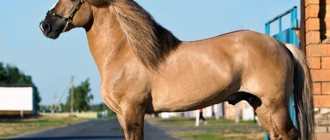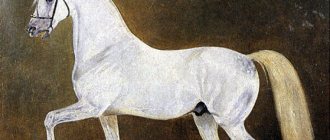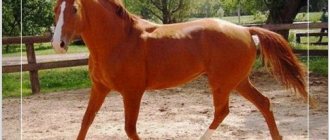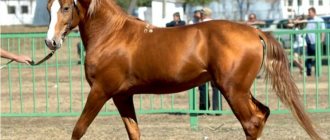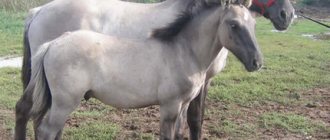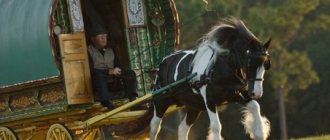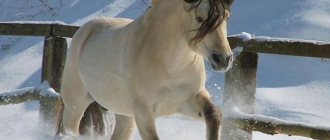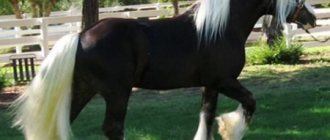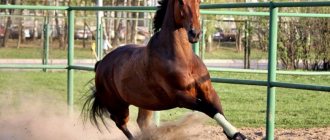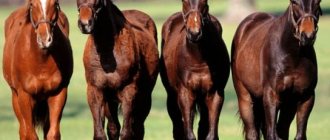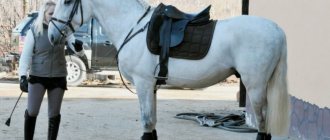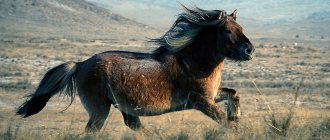The Savras color of the horse has been inherited by modern breeds from their ancestors practically unchanged. This combination of colors and shades is formed by nature and is not the result of the work of breeders. Moreover, this feature of appearance is found in several breed lines of animals and has different variations.
Savras horse color
Description of Savras suit
The name of this suit was formed several centuries ago. It probably appeared in Central Asia. Translated from one of the languages of this region, the word means “pure yellow.” In fact, this name suits the color.
The Savras suit is characterized by the following features:
- most of the horse’s body is colored predominantly in light red, which is a secondary color;
- A dark (usually brown) belt runs along the back from the base of the tail to the withers; it represents the main color;
- the animal's head can also be painted in a basic, more saturated color;
- some representatives of the suit have completely light, extensive spots on the peritoneum and the inside of the limbs.;
- the main color can also be seen on the tail and the end of the horse’s legs.
It is worth noting that the color of the head may vary depending on the color variations of the animal. The red-savage living creatures have a red head. For horses with a predominance of bay and dun color as the main color, the coloring of the head will also be appropriate.
In addition to the listed main aspects of the exterior of stallions with Savras color, they can also exhibit other, rarer features. These include:
- Snow-white strands in the tail and mane, which stand out against the background of other, darker hair.
- Dark horizontal stripes on the limbs. They are also called zebroid. Such lines are painted in the main color and in the lower part of the legs practically turn into a solid spot. Above the hock joint the zebroid pattern becomes more pronounced.
- Dark mesh or stripes on the horse's forehead. This pattern is quite rare and can vary greatly among different media. Professional breeders have dubbed it the “spider web.”
- A dark line running from the withers to the shoulders. It was called "wings". They are located across the body of the animal. Most often, this appearance trait is manifested in representatives of the Bashkir breed.
It is generally accepted that Savrasaya does not belong to the main group of suits. This coloring is considered “wild”.
What does the color say?
The color of a horse depends on a certain combination of genes in its genetic code. Color is not only the color of the coat, but also the color of the skin underneath it. Black fur grows on areas of dark skin, and light fur grows on pink skin. In cases with gray coloration, the skin may be dark. In some horse breeds, patches of dark skin may be visible under the light coat.
A pigment called melanin is responsible for the intensity of the color. The more of it in the skin, the darker the individual. Animals that do not have this pigment have snow-white fur and red sclera of the eyes. They are born quite rarely and are called albinos. Isabella horses also have little melanin. They have a light pearl-colored coat and faded, almost transparent eyes.
The color of an animal may change depending on age, time of year or conditions of detention. With good feeding and maintenance, the horse's coat has a smooth, silky texture, but if there is a lack of nutrients, vitamins and minerals, the coat fades and has a disheveled appearance. Also, diseases, including skin diseases, can negatively affect the appearance of the animal.
Genetics
All of the listed features of the appearance of Savras horses are dictated by a specific dominant gene, which is called DUN. Its main task is to lighten the hair on the body, legs and neck of animals. But, at the same time, its effect does not apply to the hair of the mane and tail. Also, only red and black wool is subject to lightening.
Most researchers consider this genetic feature to be a natural protective mechanism of wild horses, which has been formed over many thousands of years. Such camouflage hid the herds in the high vegetation of the steppes, which made them more invisible to large predators. This made it possible to save the number of animals.
Reference. Based on studies of the DUN gene and the breed lines in which it manifests itself, they can rightfully be considered one of the most ancient on the planet.
Gene type
The dominant gene responsible for lightening the coat pigment is designated DUN. Its influence extends to the black and red coat of the body, but does not affect the tail, mane, narrow stripe on the back and the bottom of the limbs.
Horse colors with the DUN gene are among the most ancient. This color was created by nature to protect animals from the attacks of large predators - this is a kind of camouflage so that in the steppe the herd remains unnoticed from afar. To maintain the population size in the wild, the savras suit is optimal.
The dominant gene does not affect the color of the mane, tail and legs.
Types of suit
The specified gene provides the characteristic color zonation of the Savras suit. But it does not imply a specific color combination. Therefore, this category includes several types of colors. The main ones include:
Varieties of suits
- Bay-brown appearance. In such animals, the body, head and partially limbs are colored pale brown. Moreover, it can be either very faded, or, conversely, dark. In the first case, dirty white or brown color in light colors prevails. In the second, the shade of the body and head is darker, and the belt, mane hair and tail are completely black.
- Bulano-savras type. This color most clearly replicates the coloring of wild horses. The color of the body, neck and head varies within several shades of yellow. The mane, belt, tail and lower legs are black. Moreover, they often contain completely blond hairs.
- Gray-savory type. It appears rather as one of the varieties of bay-savras. Long hair color is brown, but may include gray streaks. The secondary color on the body is beige with minor admixtures of gray. A distinctive feature of this species is also the expressive dark brown “wings” that extend from the withers to the shoulders. This coloring most often appears in young Przewalski's horses.
- Raven-like appearance. The body color of representatives of this type of color is heterogeneous and includes hair of gray, brown and black colors. The mane, belt and tail are black. Some variations of this color suggest the presence of light spots in the eye area, as well as on the buttocks and lips.
- Red-brown color. It involves a combination of a light red body with a brown belt along the ridge and a patchy mane, in which white, brown and red hairs appear. Often the coloring is complemented by striped legs.
In addition to the standard, each of the listed types is found in several variations, differing in shade.
Characteristics
The zonal color of trotters is obtained “due to the fault” of a lightening gene, which affects the tone of the coat on the horse’s body. However, the color of the tail and mane is not subject to this effect. Savrasost is characterized by a pale yellowish color of the hairs. The predominant shade of the coat is sandy, light red. There are horses that show tan marks of light tones, which are located on the inside of the limbs and on the belly. This color option is called under-coloring.
The color, which is defined as savrasaya, is characteristic of horses living in their natural environment. A famous representative is the Przewalski horse. Since this coloring is historically characteristic of undomesticated horses, savage is considered to be the color of wild trotters.
Breeds of horses of Savras color
Savras color is found in various breeds of horses. Moreover, each of them inherited it from their ancestors who lived several thousand years ago. Today, the most popular breed lines of this color include three:
- Fjord.
- Bashkir.
- Przewalski's horse.
Fjord
Small horses of the Fjord breed come from Norway, or more precisely from its western regions. From time immemorial they have lived in Scandinavia and have an ancient history.
Initially, all fjords lived in forests. About 2 thousand years ago they were domesticated by the local population. They were originally used by the Vikings in military campaigns. But with the advent of more peaceful times, such animals were gradually retrained for working in the fields and transporting goods.
The height of such horses, as a rule, does not exceed 154 cm. They have gained wide popularity in everyday life and military affairs due to a wide range of advantages. The main ones among them are:
- extraordinary endurance;
- force;
- calm good disposition;
- resistance to various diseases.
Typically, the fjords have survived to this day unchanged. In the entire history of these animals, they have never been crossed with other varieties of horses.
Small Fjord horses
As for the color of such living creatures, the prevailing color is light brown. The limbs, head, neck and body of the animal are painted in it. The mane of these horses has a special structure. Along its entire length there is black hair in the center. On the sides, the central row is complemented by rows of light hair. Given this feature, animal owners often cut the dark part less than the light part, which gives the mane an original look.
Bashkir
The Bashkir variety comes from crossing forest horses that lived in the forests of northern Bashkiria and steppe horses from Asia. Most researchers claim that Bashkir horses inherited their wild and unbridled temperament, for which they became widely famous, from the Tarpans. The color of animals also comes from them. Today, the main breeding areas for such horses are Bashkiria, Kalmykia and Tatarstan.
Horses of this variety are used for horseback riding and sledding. They are distinguished by outstanding endurance and unpretentiousness to living conditions. In addition, such living creatures feel good even in severe frosts. Since ancient times, these horses have been kept for year-round grazing. In winter, they independently find food for themselves, tearing apart the snow mass and looking for dry grass and branches. They are driven into special covered pens only during strong winds or snowstorms.
It is worth noting that one of the main features of Bashkir horses is their proud and willful disposition. They treat strangers extremely warily, and sometimes with aggression. Moreover, the stallion drives away all uninvited guests from the herd, with the exception of those people and animals to which he is accustomed.
In addition to being used for riding and transporting goods, Bashkir horses also provide owners with a large amount of milk. The average milk yield of one mare per year ranges from 1500 to 2000 kg.
Fjord - an irresistible Norwegian
Fjord is a gray Norwegian horse. Representatives of the Fjords are considered the purest breed: their blood does not contain foreign impurities. They are not excessively tall (reaching a height of 155 cm), but are considered powerful and hardy horses, having gained their fame back in the days of the ancient Vikings, who used them for horse racing. Fjords were also used for rural work, farming, various cargo transportation and other things.
The Fjords are descended from the Scandinavians, who were tamed more than 2,000 years ago. Savrasy fjord can have either a light or darker, brown color, which is poorly defined by an unprofessional eye. The breed is distinguished by its calm and moderate character and soft gait. The outside of the mane is covered with black hair, and the inside is light, so it is cut as short as possible in order to highlight the black stripe. Fjords cannot be dun, as crossing leads to further breakdown of the pigment in the foals. Fjord has one suit.
Brief description of the Bashkir stallion
The Savrasy Bashkir horse is a local breed that has become widespread in Bashkiria. To obtain a modern horse, steppe Asian horses and forest horses of the North were crossed. Tarpans are considered the most ancient ancestors of the Bashkirs, but it is difficult to confirm this, because the Tarpan horse is a long-lost species.
- Representatives are characterized by zonal coloring.
- Bashkir horses are considered unspoiled, persistent and tireless animals.
- The breed will not be frightened by the frosty winter, since it is on the pasture around the clock and all year round.
- During winter shedding, their fur thickens and lengthens, but is hypoallergenic.
Bashkirs prefer to eat dry steppe grass, which is found even among the snow. To keep them, pens are selected and special covered buildings are set up where they can hide from bad weather. Horses of this breed are distinguished by independence, courage and bravery. They are true protectors of their mares and their owner. Bashkirs will be excellent partners for horseback riding and sledding. Mares are often used for milk.
Thus, wild savrasaya is presented to the world in limited quantities. However, due to their uniqueness and originality, such horses remain popular and in demand. The original color and independent character are what distinguishes representatives of this species.
Markings
Markings are allowed on most suits. They are white areas on the face or limbs and do not affect the determination of the base color.
The most common ones:
- “socks” - white areas on the lower part of the limbs, near the hooves;
- star - a small spot on the forehead;
- blaze - a white longitudinal stripe along the horse's muzzle, can be narrow or wide, sometimes intermittent;
- bald spot - a wide blaze that covers the eyes and nostrils;
- a lantern is a very large nick that extends to the upper and sometimes lower lip.
It is not always easy to accurately determine the color of a horse, even with factory horses. This characteristic is present in the documents, where all the nuances and marks are indicated. Despite the fact that modern selection is aimed at working and sporting qualities of animals, many breeds continue to retain their original colors.
